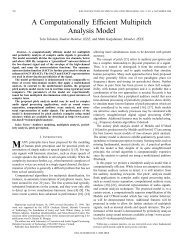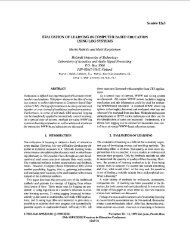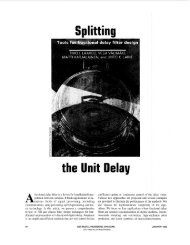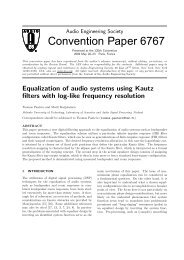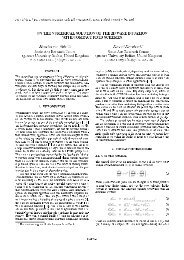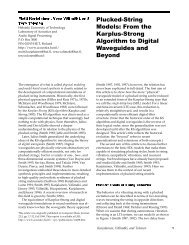Physical Modeling of Plucked String Instruments with Application to ...
Physical Modeling of Plucked String Instruments with Application to ...
Physical Modeling of Plucked String Instruments with Application to ...
Create successful ePaper yourself
Turn your PDF publications into a flip-book with our unique Google optimized e-Paper software.
PAPERSPHYSICAL MODELING OF PLUCKED STRING INSTRUMENTS<strong>to</strong> record and replay performances. Unfortunately this technique cannot be used in real-A platform-independent MIDI message dispatch sys- time performance.tem has been built on <strong>to</strong>p <strong>of</strong> the low-level interface.Message dispatching is accomplished au<strong>to</strong>matically by 6.7.3 Special Control Modesthe CLOS method dispatching mechanism, since the ge- We have experimented <strong>with</strong> advanced control modesneric method process-midi-message is specialized on for the guitar synthesizer. They help in creating a naturalboth the instrument class and the type <strong>of</strong> MIDI message, sounding guitar performance using a standard MIDI key-The MIDI control interfaces are implemented as differ- board. Two basic styles have been investigated--soloent instrumentclasses,playingand strumming.Solo Guitar: Playing a guitar solo is slightly different6.7 Operating Modes from using the MIDI mono mode. On the guitar a soloThe interactivity <strong>of</strong> Lisp makes it easy <strong>to</strong> experiment is usually played on several strings. Therefore au<strong>to</strong>matic<strong>with</strong> different control strategies. We have developed sev- string allocation is used. In the solo mode all specialeral different modes, partly <strong>to</strong> overcome the limitations playing techniques that will be discussed later areposed by MIDI itself or <strong>to</strong> facilitate playing "guitarlike" available.on a normal keyboard. The keyboard, <strong>of</strong> course, by no Rhythm Guitar: One difficulty <strong>of</strong> playing voiced guitarmeans can replace a guitar controller (just as much as chords correctly on the keyboard is the relatively largethe synthesizer does not replace the acoustic guitar), but internote separation <strong>of</strong> the chord members. To reducethese specialized modes help getting the most out <strong>of</strong> the this problem we have implemented an intelligent chordsynthesizer in terms <strong>of</strong> fidelity and ease <strong>of</strong> playing, recognizer, allowing simplified chord fingering. The algorithmtries <strong>to</strong> fit different chords <strong>to</strong> the depressed keys6.7.1 Standard MIDI Modes and the most probable chord is selected (such as A, Am,In order <strong>to</strong> be able <strong>to</strong> use existing MIDI files se- A7). It is then revoiced for the guitar using look-upquenced by others we have implemented the standard tables. When alternative voicings are possible (as inMIDI control modes as an option, most cases), the position <strong>of</strong> the previously played chordMono Mode: The MIDI mono mode is <strong>of</strong>ten used <strong>with</strong> can be used <strong>to</strong> select the chord in the closest position.MIDI guitar controllers <strong>to</strong> send the performance data The player can influence the selection <strong>of</strong> the chord posionseparate MIDI channels for each string. This mode tion by using different octaves <strong>of</strong> the keyboard.simplifies the MIDI implementation in the receiver. Eachperformancestylecanhaveitsownset<strong>of</strong>chords,There is one sound genera<strong>to</strong>r per channel, and there is which is based on the most <strong>of</strong>ten used chords <strong>of</strong> theno need for voice allocation. Ambiguous pitches, which given style. Furthermore, styles can contain chords thatcould be played on different strings, do not cause a use only the upper strings, leaving the lower strings freeproblem. Pitch bend can be used individually on differ- for playing bass notes, as in folk or Latin-Americanent strings <strong>with</strong>out affecting other notes, styles. In this case the bass notes can be played onWhile the mono mode is perfectly suited for the MIDI another part <strong>of</strong> the keyboard using the keyboard splitguitar, it is difficult <strong>to</strong> use it <strong>with</strong> a keyboard. Although mode, or they can be played by using a special notekeyboardsplit could be used <strong>to</strong> send data on different triggering mode. The notes are not triggered immedichannels,playing chords is quite difficult if not impossi- ately by fingering a chord, but separate keys--one keyblethis way.per string--are used <strong>to</strong>pluckthestringsafterward.ThisPoly Mode: In the poly mode the data for all strings technique can be used for playing nice arpeggios as well.are received on a single MIDI channel, and the control With these techniques many common guitar styles caninterface has <strong>to</strong> assign the notes <strong>to</strong> available sound gener- be played from the keyboard <strong>with</strong> little effort.a<strong>to</strong>rs. There is a potential problem <strong>with</strong> instruments <strong>of</strong>the variable source type. Assigning a different genera<strong>to</strong>r 6.8 Mixing Control Modes<strong>to</strong> a new note will not result in a correct transition. <strong>String</strong> It is possible <strong>to</strong> switch between control modes duringallocation is necessary for most string instruments, performance. This feature helps <strong>to</strong> play chordal solosinterleaved <strong>with</strong> short runs. It is also possible <strong>to</strong> split6.7.2 Smart MIDI Modes the keyboard and define different control modes overSmart MIDI modes are enhanced MIDI modes. While the two ranges.they accept MIDI events intended for normal use, theytry <strong>to</strong> add more details <strong>to</strong> the sound, such as by splitting 6.9 Special Techniquesthe "note on" <strong>to</strong> separate pitch set and note start events. In this section we discuss some special playing tech-Since setting the pitch happens before starting the note, niques not available on keyboard instruments. Thesethis can only be achieved by delaying the start <strong>of</strong> a techniques can be simulated <strong>with</strong> our intelligent connoteby a small amount. Other enhancements, such as trol interfaces.au<strong>to</strong>matic fret noise generation, need even more delay.Allowing a relatively large (0.5-1 s) constant pro- 6.9.1 Hammer-On and Puli-Offcessing delay helps in both cases. When the synthesizer Hammer-on and pull-<strong>of</strong>f are left-hand techniques thatis driven by a sequence, the delay can be compensated a guitar player sometimes uses <strong>to</strong> pluck a note. By strikbyadvancing the given track by the amount <strong>of</strong> delay, lng a finger against a fret, one can set the string in<strong>to</strong>J. Audio Eno. Soc., Vol. 44, No. 5, 1996 May 349i I II






